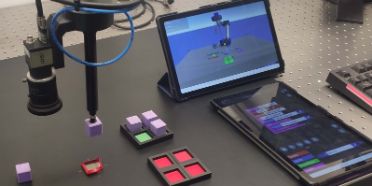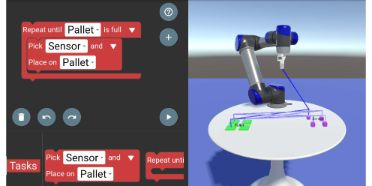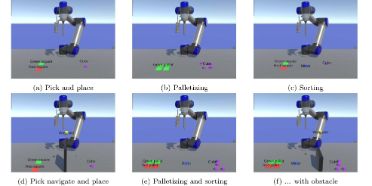Upskill at Work
Digitization is redefining work and the skills required of workers. In particular, new interfaces for acquiring robot control skills are needed for agile production.
Factsheet
- Lead school School of Engineering and Computer Science
- Institute Institute for Human Centered Engineering (HUCE)
- Research unit HUCE / Laboratory for Computer Perception and Virtual Reality
- Funding organisation BFH
- Duration 01.01.2021 - 31.12.2021
- Project management Prof. Dr. Sarah Dégallier Rochat
- Head of project Prof. Dr. Sarah Dégallier Rochat
- Keywords Human-Machine Interaction, Robotic Programming, Upskilling
Situation
Digitalization is transforming work through the introduction of new technologies such as artificial intelligence and robotics. New jobs are created, while others tend to disappear. Many of the new jobs in Switzerland are high-skilled jobs, most of them requiring digital skills. However, Switzerland, as the rest of Europe, is experiencing a shortage of skilled workers. While many continuing education programs are offered to acquire digital skills, they mainly target people with a university-level background, while the jobs that tend to disappear are rather medium skill jobs. People with lower educational background tend to be more reluctant to traditional adult learning activities, making continuing education challenging. New forms of training based on work experience and worker needs are thus required to upskill people with a middle and lower educational background to ensure work mobility and prevent a shortage of skilled people.
Course of action
The project aims at developing a human-machine interfaces (HMI) for robotic programming that foster the acquisition of digital skills through experimental learning rather than symbolic cognition. To do so, this project will explore the key factors to successful learning for adults with non-academic background in the work environment, the design of HMIs that are intuitive and anchored in the task knowledge of the worker and the use of these HMIs for the acquisition of new digital skills. On the long term, this project aims at contributing to: providing educational tools for digital skill acquisition based on embodied cognition and work experience, overcoming the existing barriers for participation in the digital transformation, fostering upskilling and employment mobility for people working on the shop floor and reducing the shortage of skilled people in the Swiss Industry. A user-centered design approach was planned for the project. However, due to the COVID-situation, it was not possible to interact with the target users. The programming interface was thus developed based on the existing literature.
Result
A visual programming language targeted for robotics was developed based on the tried and tested framework developed by Google, Blockly. Six different tutorials presenting basic concepts in programming such as functions, parameters or loops were developed. The interface was tested in two experiments, with each 58 participants. The first experiment was performed with students from the business school (BFH-W). The system was then lent to the University of Fribourg and used for a second experiment in the framework of two Bachelor theses. A conference article is in preparation to present the results of both experiments. In general, the interface was positively rated by the users and a significant, positive effect on programming anxiety could be shown. However, more tests are required to robustly assess the performance and the usability of the proposed system.
Looking ahead
We will have the opportunity to test the interface with the target users in the framework of a follow-up Innosuisse project: Agile Robotics for High-Mix Low-Volume Production. A user-centered approach will be taken to design the interface for both operators and technicians, including observations, interviews and workshops. The interface is also part of the software AutoMate that we have developed for the flexible programming of robots. A spin-off has been created thanks to the support of New Venture Programm of the Gerbert Rüf Foundation. It aims at making automation profitable for SMEs by fostering employees upskilling.



